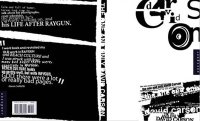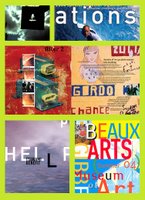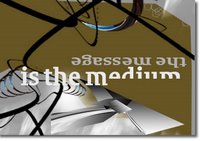Wednesday, August 30, 2006
Tuesday, August 29, 2006
On-going Project
Each week you will shoot 5-10 images of interesting typography in your environment. Look at signage (hand-lettered signs are sometimes fascinating as is unique typography), letterforms found in your environment that may not necessarily be seen as letterforms, or other things related to typography that you find. If you do not have a digital camera or access to a cell-camera we will discuss an alternative to gathering images.
I will ask that once a week you email me one image by Monday no later than 6pm and I will post the image to the blog with your name. Please down-size that image to 5" wide at 72dpi as either a jpeg or png file but be sure to keep your original file in the quality that you captured it. Classmates can feel free to comment on the picture through the blog. These images will be used to create a retrospective of your found typography – format to be determined at a later date. Keep all of your images in one folder and you may want to back them up on an ftp, jump drive, or other media so that you will not lose any of them along the way.
Designers who work in a similar style:
[ Ed Fella ]
[ David Carson ]
You do not need to purchase these books unless you wish to add them to your collection. Ed Fella's book is available in the library but I ask that you make copies if you wish but please leave the book for others to view.
Each week you will shoot 5-10 images of interesting typography in your environment. Look at signage (hand-lettered signs are sometimes fascinating as is unique typography), letterforms found in your environment that may not necessarily be seen as letterforms, or other things related to typography that you find. If you do not have a digital camera or access to a cell-camera we will discuss an alternative to gathering images.
I will ask that once a week you email me one image by Monday no later than 6pm and I will post the image to the blog with your name. Please down-size that image to 5" wide at 72dpi as either a jpeg or png file but be sure to keep your original file in the quality that you captured it. Classmates can feel free to comment on the picture through the blog. These images will be used to create a retrospective of your found typography – format to be determined at a later date. Keep all of your images in one folder and you may want to back them up on an ftp, jump drive, or other media so that you will not lose any of them along the way.
Designers who work in a similar style:
[ Ed Fella ]
[ David Carson ]
You do not need to purchase these books unless you wish to add them to your collection. Ed Fella's book is available in the library but I ask that you make copies if you wish but please leave the book for others to view.
Project 1
Create a list of 15 adjectives to describe yourself. These can be attributes of your character that may relate in some way to your professionalism but they should be more representative of the traits you feel that you possess on a personal level.
This first project is computer-based. You may use Illustrator or InDesign for the execution.
1) Create a 7.5 x 7.5 box as your boundary select 10 adjectives that you will work with.
2) Set the words using only one typeface. Consider the following: grid, white space, placement (relationship of words to each other), emphasis, kerning, size, all caps vs. lower case/italic vs. bold, light, etc. Do not use color at this point, work only in black and white (no shades of gray yet).
3) Create 2 initial solutions that you will show during the next class. Print each on an 8 1/2 x 11 sheet of paper centered with a .25pt rule around the 7.5 square box.
From that point we will work on refining the project towards a final solution.
Next class we will begin reviewing terminology and basic rules towards typography.
Create a list of 15 adjectives to describe yourself. These can be attributes of your character that may relate in some way to your professionalism but they should be more representative of the traits you feel that you possess on a personal level.
This first project is computer-based. You may use Illustrator or InDesign for the execution.
1) Create a 7.5 x 7.5 box as your boundary select 10 adjectives that you will work with.
2) Set the words using only one typeface. Consider the following: grid, white space, placement (relationship of words to each other), emphasis, kerning, size, all caps vs. lower case/italic vs. bold, light, etc. Do not use color at this point, work only in black and white (no shades of gray yet).
3) Create 2 initial solutions that you will show during the next class. Print each on an 8 1/2 x 11 sheet of paper centered with a .25pt rule around the 7.5 square box.
From that point we will work on refining the project towards a final solution.
Next class we will begin reviewing terminology and basic rules towards typography.
Friday, August 25, 2006
Syllabus
These courses (Typography 1, 2 ) include the history, design, and execution of lettering for reproduction. The computer is employed to introduce the student to the basic principles of typographic design and typesetting.
“Typography has one plain duty before it and that is to convey information in writing. No argument or consideration can absolve typography from this duty. A printed work which cannot be read becomes a product without purpose. More than graphic design, typography is an expression of technology, precision and good order.” Emil Rudder
Typography is the foundation of every project, it is the most important item in terms of legibility and transmission of message, however it is the single most overlooked aspect of design. Many feel they are an expert in typography and call themselves typographers without knowing the meaning of the very word. My goal is to teach you how to analyze, evaluate, and deconstruct the typography you encounter on an everyday basis.
Instructor
Michael Gray, 917 599 6763, michael@liquidfuxion.com
Programs Discussed
Adobe Illustrator CS2; Adobe InDesign CS2
Attendance
The continued registration of any student is contingent upon regular attendance, the quality of work and proper conduct. Irregular attendance, neglect of work, failure to comply with Institute rules and official notices or conduct not consistent with general good order are regarded as sufficient reasons for dismissal.
There are no unexcused absences or cuts. Students are expected to attend all classes. Any unexcused absences may affect the final grade. Three unexcused absences may result in course failure at the discretion of the instructor.
You are expected to attend every class meeting. Please do not come to class late. Multiple tardies will result in a drop of letter grade. Full information on the attendance policy can be found in the student handbook.
Grades
Demonstration of assignment subject comprehension, 25% Handskills, 25% Technical skills, 25% Fulfillment of assignment specifications, 15% Deadline adherence, 10%.
A, Exceptional; B, Very good; C, Average; D, Below-average; F, Failing
Events
Nov 22, Thanksgiving
Dec 06, Last Class
Dec 13, Junior Survey, 10a – 2p
Materials and Readings
Additional resources will be announced in class and added to the blog.
These courses (Typography 1, 2 ) include the history, design, and execution of lettering for reproduction. The computer is employed to introduce the student to the basic principles of typographic design and typesetting.
“Typography has one plain duty before it and that is to convey information in writing. No argument or consideration can absolve typography from this duty. A printed work which cannot be read becomes a product without purpose. More than graphic design, typography is an expression of technology, precision and good order.” Emil Rudder
Typography is the foundation of every project, it is the most important item in terms of legibility and transmission of message, however it is the single most overlooked aspect of design. Many feel they are an expert in typography and call themselves typographers without knowing the meaning of the very word. My goal is to teach you how to analyze, evaluate, and deconstruct the typography you encounter on an everyday basis.
Instructor
Michael Gray, 917 599 6763, michael@liquidfuxion.com
Programs Discussed
Adobe Illustrator CS2; Adobe InDesign CS2
Attendance
The continued registration of any student is contingent upon regular attendance, the quality of work and proper conduct. Irregular attendance, neglect of work, failure to comply with Institute rules and official notices or conduct not consistent with general good order are regarded as sufficient reasons for dismissal.
There are no unexcused absences or cuts. Students are expected to attend all classes. Any unexcused absences may affect the final grade. Three unexcused absences may result in course failure at the discretion of the instructor.
You are expected to attend every class meeting. Please do not come to class late. Multiple tardies will result in a drop of letter grade. Full information on the attendance policy can be found in the student handbook.
Grades
Demonstration of assignment subject comprehension, 25% Handskills, 25% Technical skills, 25% Fulfillment of assignment specifications, 15% Deadline adherence, 10%.
A, Exceptional; B, Very good; C, Average; D, Below-average; F, Failing
Events
Nov 22, Thanksgiving
Dec 06, Last Class
Dec 13, Junior Survey, 10a – 2p
Materials and Readings
Additional resources will be announced in class and added to the blog.














